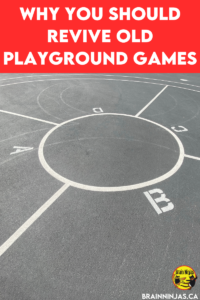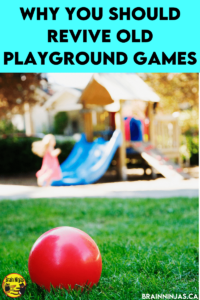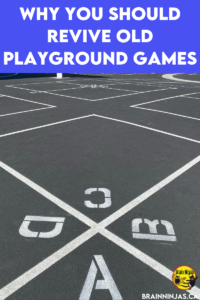
Are you looking for something quick, easy and fun to do in the gym or outside at recess? We’ve been searching for games that students can play that don’t require a lot of equipment and or are simple enough that students can play them on their own with adult support. Playground games are the answer!
Students love older playground games that seem new to them. Even something as basic as teaching students a new chant to use while skipping can boost engagement. Read more to learn how we use playground games to build relationships, get in some physical activity and have some fun!
Our problem is that our school has a limited amount of space to play on the blacktop and it is usually dominated by a group of kids who love to play basketball year-round (it’s always fun when the basketball gets stuck in the frozen net). The field is usually dominated by a group of soccer players. While everyone is welcome to join these games, many students don’t want to play a large team sport. They would rather play with a smaller group of people.
We feel that building a strong classroom community is a priority. If you’re looking for more ways to foster teamwork and cooperation, check out our Classroom Community Unit, which is available on TpT ($USD) and our BN Shop ($CAN).
These are the playground games that our students love to play (and some of them are traditional games that have been modified by our students.

Our Favourite Playground Games
Bean Bag Bocce
This is a simple twist on Bocce ball that can be played inside the gymnasium or in a field.
Equipment
5 beanbags (2 in one colour, 2 in another colour, and 1 in a third colour — this is called the jack)
Number of Players
This game can be played with 2 or 4 people.
General Play
Students can play as individuals or teams. If students are playing as individuals, they will throw two bean bags from each end. They will walk back and forth to play each end. When students play as four, two players will be one colour and the other team will be the other colour. One player from each team will stand at each end. Each player will toss 2 bean bags, but players will stay in place.
How to Play
One player tosses the single-coloured bean bag. Players will take turns tossing their coloured bean bags, trying to get as close as possible to the single coloured bean bag called the jack.
Scoring
The bean bag that is closest to the jack scores a point. If two of the same colour land closest to the jack, then that player or team earns two points.
How to Win
Students can choose a number to play to or choose a certain amount of time. The player or team with the highest score when the game ends wins.
Ninja Note
If you are playing again, the loser gets to throw the jack first. They also get to toss first.
Frisbee Hoop Golf

This is a game where students practice trying to land a frisbee inside a hula hoop. You can easily use orange traffic cones if that’s all you have available. Instead of landing inside the hoop, students can hit the cone with the frisbee.
Equipment
1 frisbee per player/team, a bunch of hula hoops that can be spread out over an area.
Number of Players
Any amount of players can play, but it works best if there is one hula hoop for each player or team, so no one has to sit around waiting for a turn.
How to Play
Arrange the hoops and decide on the order in which they will be played. Have one student stand to aim at each hoop. We find that students shouldn’t be too close to the hoop, but it depends on how much space you have. This is a great game for outside in a field.
Students will aim their frisbee, trying to get it to land inside the hoop. Decide before the game begins what will happen if the frisbee lands ON the hoop or is touching the hoop. Students need to keep track of the number of shots they need to take to get it to land in the hoop. Once they’ve landed in the hoop, they will go wait at the next spot until the player ahead of them has cleared their hoop. Continue playing until the players have played through all the hoops or until the time runs out.
How to Win
The player with the lowest number of shots wins.
Ninja Note
If you are playing teams, the players alternate between shots or between hoops.
Queenie-I-Over
This one always shocks us. The kids LOVE it and yet it’s SO simple. This is an old British game with a twist. We call it apple-i-over because we play with a squishy stuffed apple instead of a ball, but any hand-sized, softer, ball-like object will work. We have played with a stress ball, nerf ball, dog toy, and even a bean bag.
Equipment
Any hand-sized, ball-like object that is safe to be dropped and won’t injure students if it hits them in the face.
Number of Players
3+ (We’ve seen two people play it, but that’s not very exciting).
How to Play
The tosser holds the object and stands with their back to everyone else. The tosser yells “Queenie-i-over” (or whatever you’ve decided to call the game) and then throws the object up over their shoulders into the people standing behind them. Everyone tries to catch the object. If no one catches it (it touches the ground at any point) then the tosser tosses again. If someone catches it, they become the tosser.
How to Win
This game goes on forever, and there is never really a winner, but some of our students figured out that tossing the object different distances made it more difficult to catch, and therefore they got to be the tosser for a longer period of time.
Ninja Note
If your class is too big, you can divide them into slightly smaller groups )we divided the class in half) so more people can have the chance to become the tosser. We spread them out in the field or on opposite sides of the gymnasium.

Capture the Flag
This is a great game for those times when you need to cover some extra students or can take two classes outside together in a large area to get lots of wiggles out.
Equipment
A “flag” for the two teams (you can use anything that is easy to carry, but avoid items that can turn into a tug of war, optional markers for the cage (four per team to make a boxed-off area.
Set-Up the Game
Divide the playing area in half. If you are playing with cages, place the markers near the back of the player area. Each team places their flag inside their playing area away from the cage markers.
How to Play With Cages
Players will cross into the opposing team’s area in an attempt to grab their flag and bring it back to their own side. If a player is tagged by an opposing player while on the opposing team’s side, they go to the cage. Players can rescue their players. If they are able to run to the cage without being tagged, they can walk one player back to their own side. Once they arrive back on their own turf, they are free to continue playing. Players cannot rescue a player and grab the flag in the same trip across to the opposing team’s side. If a player is tagged while they hold the opposing team’s flag, the flag is returned to its spot, and the player goes to the cage. Players cannot toss the flag from player to player in an attempt to get it back to their side.
How to Play Without Cages
Players will cross into the opposing team’s area in an attempt to grab their flag and bring it back to their own side. If a player is tagged by an opposing player while on the opposing team’s side, they join the opposing team. If a player is tagged while they hold the opposing team’s flag, the flag is returned to its spot, and the player joins the opposing team. Players cannot toss the flag from player to player in an attempt to get it back to their side.
How to Win
Get the opposing team’s flag to your side of the playing area.
Ninja Note
We don’t allow students to “puppy guard” the flag. This means no players are allowed to sit or stand near their team’s flag for more than 3 seconds.
This game can be lots of fun if you have the option to play in a treed area. As long as you can see students (for safety reasons), hiding the flag in the trees can be lots of fun.
If you’ve got some students who love a challenge, send them outside with the Nature Scavenger Hunt. You can find it in our Resource Library if you’re already a ninja. Otherwise, we can send it directly to your inbox when you sign up for our email list.
7-Up
This is a childhood favourite.
Equipment
You will need to play on a hard surface with a wall. We used to play on the blacktop or tarmac against the gym wall which was made of cinderblocks. It shouldn’t be played against a wall with windows (just in case). One tennis ball or a small similarly sized ball that bounces easily is needed per pair.
How to Play
Two players will take turns throwing the ball against the wall and then catching it after a specific number of bounces with one hand. We used to play with one hand behind our back and to make it even more challenging, we would catch with our non-dominant hands.
Player 1 will throw the ball against the wall, let it bounce once and then catch it with one hand. If they are successful, they get to throw the ball again, let it bounce twice and then catch it with one hand. This pattern continues all the way up to catching the ball after seven bounces. If that happens, they win.
But, if Player 1 misses the catch at any time, Player 2 gets to try.
How to Win
The first player to catch seven bounces before the time is up.

Hippo Ball
You might remember the game Hungry Hippos, where you try to catch marbles with a plastic hippo. Well, if you have small scooters, balls, and buckets (or scoops), try playing a life-size version of the game. You will need a smooth surface like a gymnasium to play.
Equipment
1 scooter per pair of students, 1 bucket/scoop per pair of students, as many balls as you can find (that fit into the bucket or scoop, buckets or baskets
How to Play
Students start along the wall. One member of the partners will lie on the scooter and hold the scoop while the other will hold the legs of their partner to drive them around the room. Teams will scoop up the balls and take them back to their team’s basket. The teacher or a designated student (works well if you have an odd number of students) will drop the balls all around the room.
We play by dividing the class in half, and then everyone partners up. Each big team has a basket at the back of their playing space. This makes students have to go farther and takes a little longer.
Another option is to divide the class in half and create two separate playing areas.
Ninja Note
Have a discussion about safety. Players need to keep their fingers off the floor to avoid having them stepped on or run over by a scooter. Drivers need to be careful not to run players into each other.
How to Win
The team with the most balls wins when the time runs out. Switch partner positions and play again.
Make the Game Harder
If students are having too much fun, throw extra balls into the game or empty the captured balls.
If you’re looking for more playground games and wellness, check out these posts:
Energize Your Gym Class With Very Little Equipment
Make Wellness a Priority in Your Classroom
Quiet Classroom Games You’ll Love
5 Games We Love More Than Dodgeball
The best part about teaching students these simple games is watching them take them outside to the playground at recess and teaching them to their friends.
Do you have any playground games that are short and simple but fun to play? Share them with us below.







